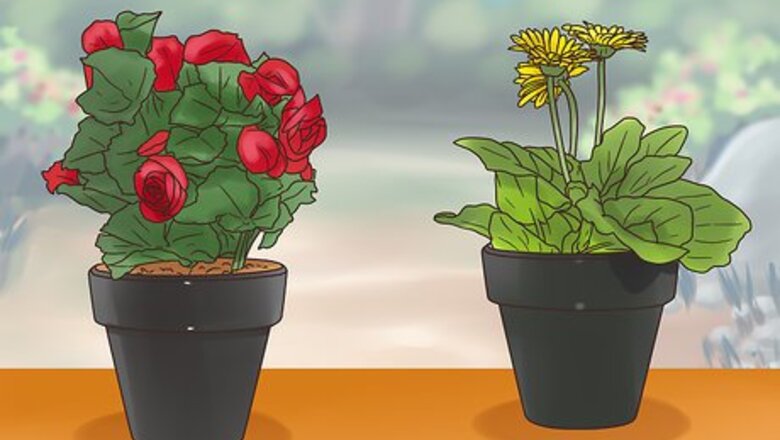
views
Selecting Potted Flowers
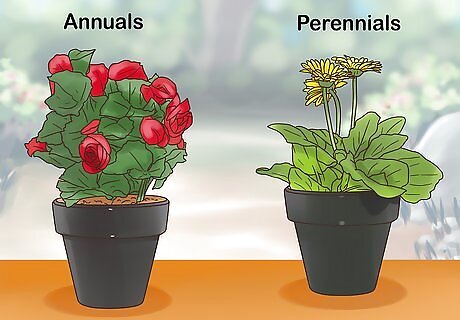
Decide if you want annuals or perennials. If you want to leave the flowers in the pots and don't mind if they only flower for 1 season, choose an annual. As long as it gets the proper light and water, the plant will flower for a full season or 2 (if the flower is a biennial). If you'd like the flower to keep growing year after year inside your home or transplant it to the ground, choose a perennial that will flower year after year. For example, pick: Annuals, such as alyssum, bacopa, begonia, and calibrachoa. Perennials, such as daisies, lavender, daffodils, peonies, and tulips.
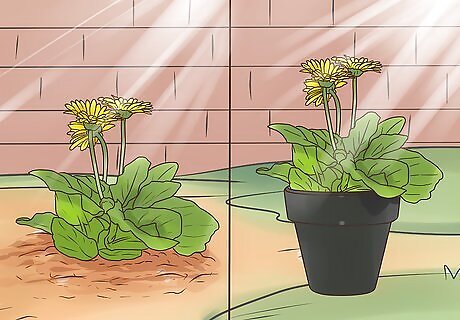
Consider the growing conditions of your flowers. The growing conditions that you have available will make a difference in the types of flowers you choose. You can find information on the flower pots or tags in the pots that describe the growing conditions the flowers require. Some things to consider before you choose a flower include: Amount of sun the flowers will get. Whether flowers will be in the ground or in pots. Size of growing area the flowers will require.

Search the inventory of local stores and nurseries. Call local stores or nurseries or check their websites to find out what flowers they have in stock. Keep in mind that their inventory will change depending on planting seasons. If you're looking for a particular plant, ask if they carry it and what varieties are available. For example, call a nursery and ask if they have lavender. They might tell you that they have French and Italian varieties to choose from.
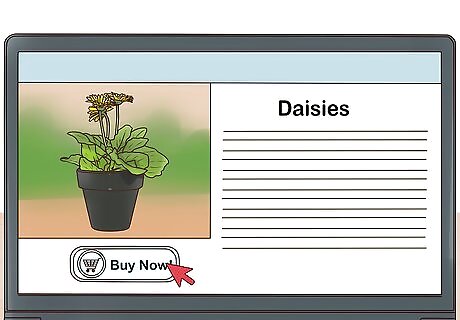
Order potted flowers online. Check local or national floral companies for potted flowers that you can order. Most companies will let you choose a single type of flower or an arrangement. Pick which container you want the flowers in and have them delivered to your home. Keep in mind that most of these containers won't have drainage holes. Instead, they'll be more like vases. If you want to keep the flowers, you'll need to transplant them to another pot with drainage holes. You cannot plant cut flowers that are in an arrangement or that come in a vase and don’t have roots. Just enjoy these flowers until they wilt.
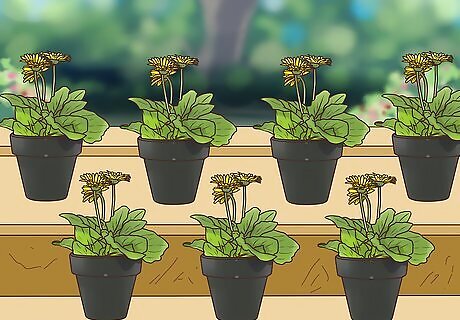
Examine the health of the potted flower selection. When you go to the nursery, check the potted plans for signs of disease. Look at the tops and bottoms of leaves to see if they're brown, dried, wilted, or unusually small. Avoid buying potted flowers that have leaf or stem damage. If you find that lots of the nursery's selection is unhealthy, consider checking a different store for potted plants.
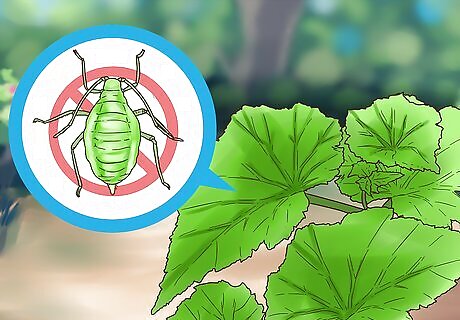
Check the potted flowers for insects. Avoid plants that have leaf damage. These may be pale, covered with a fine webbing, or be stunted since insects have been eating them. You may even see small insects on the top or undersides of the leaves. Small aphids can look like tiny black, green, or white specks.
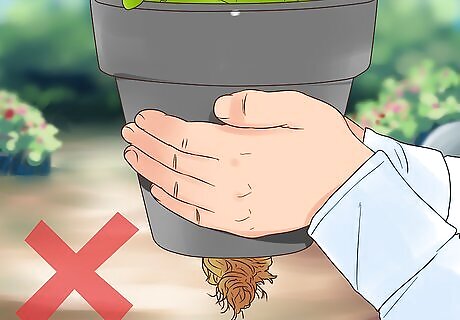
Look at the roots if the container has holes on the bottom. Once you've narrowed down your potted plant choices, lift the container up to look at the bottom. Most containers will have holes in the bottom for drainage and these holes should be visible or have roots just starting to come out of them. Avoid plants that have lots of roots winding around the base of the bottom. Root-bound plants have been growing in the container too long and have gotten too large. These roots will be brittle or dried out which makes them difficult to transplant.
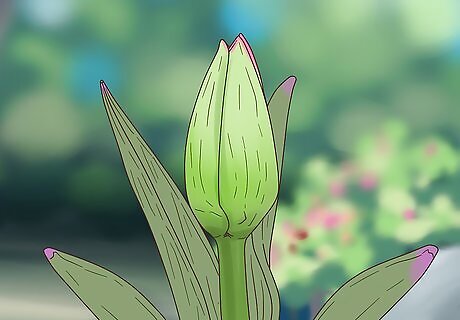
Choose a plant with tight buds. Look for plants that have tightly closed buds or barely open flowers. The flowers will gradually open once you've had them at your home for a while and they'll last longer than plants with flowers that are already in full bloom.
Caring for Your Potted Flowers
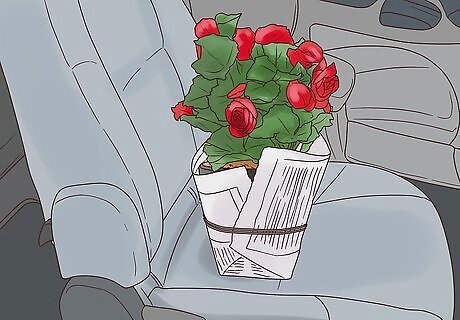
Protect your plants from extreme temperatures during transport. If you're bringing the potted flowers home during hot summer months, give them plenty of shade even if you're driving or riding in an air conditioned vehicle. Intense sun and heat can damage or kill potted flowers. If it's winter, wrap the potted flowers in paper and put them in the front seat of the car to prevent the flowers from freezing.

Let your potted flowers acclimate to your home. Once you've gotten your potted flowers home, put them in a shady place for several hours or up to 1 day. Then move the pots into the room where you plan on putting them. The potted flowers will gradually adjust to the light and humidity of their new space.
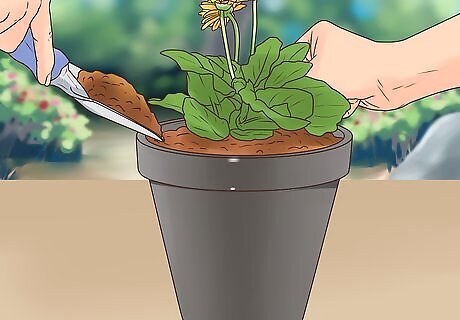
Transplant the flower to a larger pot with drainage holes. If you bought annuals in a decorative pot, you can probably leave them in the container for the season. But if your plant came in a temporary plastic container or decorative pot without holes, you'll need to buy a larger pot with drainage holes so the plant has room to grow. Fill the pot with potting soil and don't block the drainage holes. Place the flower in the pot and mound the soil firmly around the roots and stem, or around the same level the soil was at in its original pot. Water the plant until water comes out of the drainage holes. If you bought a perennial, you can transplant the flower to an outside garden. You can also do this with annuals as long as the conditions are right, but the plant will only survive until the first frost or a short while after that. Just remember to choose a space in your yard that gives your plant the proper light and water conditions. You may need to repot your plant periodically if it keeps outgrowing its containers.
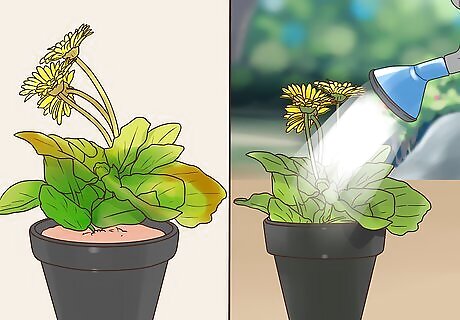
Water the plants once the top soil dries. It's easy to over water potted flowers, so only water your plant when the top of the soil is dry. Use a watering can to water the base of the plant, not the leaves. Keep pouring until water starts to come out of the bottom drainage holes and then stop. If water collects in a saucer under the pot, remove it so the plant's roots aren't sitting in the water.
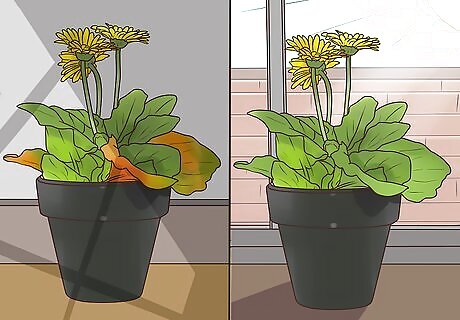
Adjust the plant's humidity or sunlight if it's struggling to grow. If you notice the leaves turn brown or crisp, your plant might be getting too much light. Move the plant to a shadier spot in your home and consider running a humidifier during the winter months. If the plant's leaves are small or pale, try moving it to a brighter spot. If you suspect the plant isn't getting enough moisture from the air, temporarily move it to the bathroom and run a shower. If the plant perks up after being exposed to the steam, find a more humid space for it. You may also mist the plant with a spray bottle once per day.
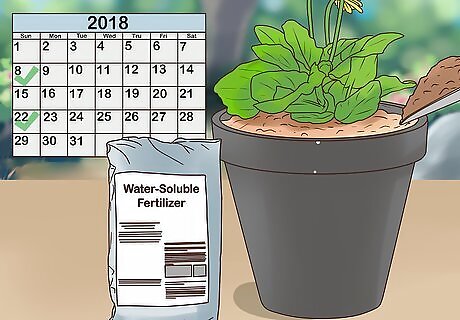
Fertilize your potted flowers about every 2 weeks. Because potted flowers lose nutrients every time you water, you'll need to add nutrients on a regular basis. Buy a liquid or water-soluble fertilizer that you dissolve and add it to your plant's water every 2 weeks. If you've planted the potted flower outside, you can add nutrients by topping it off with compost every month, or by feeding it with granular or liquid slow-release fertilizer.


















Comments
0 comment